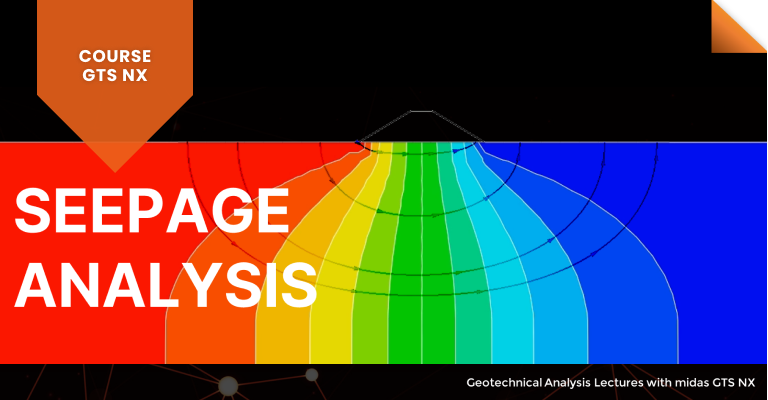-
1) What is Seepage Analysis ?
-
2) Example
-
3) Comparison of Results

10. Seepage Analysis
In this lecture, We will learn about the concepts and principles of Seepage analysis. We will understand the theoretical methods to determine seepage deeply. Also we will discuss the phreatic line theory of a dam body. Moreover, In order to comprehend the seepage utilizing GTS NX software, we will Calculate the seepage flow rate that occurs in the ground including the embankment. The findings will be compared with those obtained manually and using the program.
Chapter 1) What Is Seepage analysis
- Introduction to Seepage
- Square levee body's infiltration line theory
- phreatic line theory of a dam body.
Chapter 2) Example
- Modelling, boundary condition setting, and applying load using Midas GTS NX software to numerically calculate the seepage flow rate that occurs in the ground including the embankment.
- Analysis and see the results for the same.
Chapter 3) Comparison of results
- Compare the results with those obtained manually and using the program.
Summary
- Concept of seepage analysis
seepage analysis is performed to understand the flow behavior of groundwater within the soil.
The variables that describe the behavior of flow include velocity, hydraulic head, hydraulic pressure, flow rate, and infiltration rate.
Flow-related geotechnical structures are mainly dealt with in traditional geotechnical engineering.
These structures include hydraulic structures such as rockfill dams and underground structures such as tunnels and wells.

- Theoretical solution of ground behavior during seepage.
That is Q=Av=Aki=Ak(dh/dl)=Akγ_w ((du_w)/dl).
where A is the outflow cross-sectional area, k is the permeability coefficient, i is the hydraulic gradient, 𝛾𝑤 is the unit weight of water, and dl is the flow distance.
Flow problems involve determining the flow rate or hydraulic pressure, and the property that connects the causes and consequences of flow behavior is permeability (permeability coefficient).
The governing equations for geotechnical behavior consist of the momentum equation (Darcy's law) and the continuity equation.

The theoretical analysis involves finding the solutions of the differential equations governing the flow, and therefore, boundary conditions are necessary.
The boundary conditions for steady flow conditions are typically represented by the following four conditions.
-Boundary interface (AC): h=known (where h represents the specific energy).
-Impermeable boundary: 𝑑ℎ/𝑑𝑛=0, flow perpendicular to the impermeable surface is 0 (where n is the unit vector perpendicular to the boundary)
-Known discharge surface: 𝑑ℎ/𝑑𝑛 = a specific value.
-Free surface: The actual location is unknown, but there is no flow perpendicular to the surface (𝑑ℎ/𝑑𝑛=0), and the pressure is atmospheric pressure (z=h).

- Square levee body's infiltration line theory
Let's derive the hydraulic behavior for the rectangular cross-section of unconfined flow as shown in Figure 10.3.

If the flow per unit width (B = 1) is q, the continuity equation and the equation of motion are as follows.
-continuity equation q_in=q_out, q=vA
-equation of motion (Darcy’s law), v=ki=k dh/ds
Using Dupit's assumption, since dh/ds≅𝑑ℎ/𝑑𝑥, the equation of motion is q=𝑘𝑖𝐴= k dh/dd h, which is hdh=q/k dx.
Integrating the above equation and applying x=L, h → H to the boundary condition x=0, ℎ→ℎ𝑒, h^2=2qx/k+h_e^2, q=k/2L(H^2-h^2) and eliminating q from these two equations, equation 10.1 for the free surface can be obtained.

Applying Equation 10.1 to the continuity equation and the equation of motion, we can define the flow rate and velocity through the rectangular section.
- phreatic line theory of a dam body.
(1) Solution of Schaffernak & Iterson (α<30°)

Using the conditions 𝑥=𝐿, ℎ=𝐻; 𝑥=𝑎 cos𝛼, ℎ=𝑎 sin𝛼, we can determine the value of a as shown on the top.
The equation above requires correction because the head line and the streamline do not meet at right angles at the inlet. (Casagrande)
Also, when 𝛼 > 30°, the Dupit assumption causes a large error.

(2) Solution of Casagrande (α>30°)
When the slope of the embankment slope is large, 𝑑ℎ/𝑑𝑠≈sin𝛼. Therefore, the flow rate per unit width of the outflow surface is q=k dh/ds h=k(a sin^2α )
Here, s means the streamline direction of the free water surface.
Considering the boundary condition, it can be summarized as follows.

